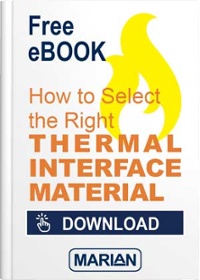When you first hear the term “thermal interface material” it sounds like the latest fabric invented by Patagonia for their new line of long-underwear. Little may you know, these materials are critical components found in the many electronics, lighting, and battery-operated devices you use every day.
Why Are Thermal Interface Materials (TIMs) Needed?
Have you ever noticed the heat generated by your laptop or your smart phone while its operating? Heat is a normal by-product of electronics operation. All electronic devices require electricity to function. As electricity passes across circuits and through wires, it meets a natural degree of resistance. This resistance creates heat.
Heat produced by the heat-generating component of the device must be removed to maintain the safe operating temperature of the device. The heat removal process is critical to the longevity of the device’s operation. So how is this done?
Often, heat removal involves conduction from the heat-generating component to a heat sink that is designed to efficiently dissipate heat. The heat sink must be carefully joined to the heat-generating component to maximize the transfer of heat. This is where TIMs come into play.
TIMs are used to bond the two components and eliminate air gaps from the interface, creating a thermally conductive bond that will more efficiently transfer heat from the critical operating components of the device.

Types of Thermal Interface Materials
A variety of thermal interface materials have been developed in response to the changing needs of the electronics market. The different types are briefly described below.
- Thermal Pads / Insulators – Typically made of polymerized silicone rubbers in the form of easy-to-handle solids that will become soft at high temperatures. Thermal pads are also known as gap pads or thermal gap pads.
- Thermally Conductive Adhesive Tapes - Acrylic or silicone pressure-sensitive tapes designed to bond the heat sink and heat-generating component.
- Phase Change Materials – Primarily waxes that are solid at room temperature and melt at high temperatures.
- Thermal Compounds or Greases – Grease substance made of silicone or hydrocarbon oils with a thermally conductive ceramic filler.
- Thermally Conductive Epoxy/Adhesives – An Epoxy or silicone-based formulation.
Each of these types of thermal interface materials contains different characteristics with their own advantages and disadvantages.
Choosing the right material for your application can be difficult. Download our Free Guide: How to Select the Right Thermal Interface Material to learn more about these materials.





